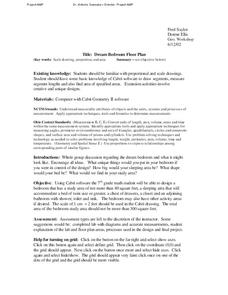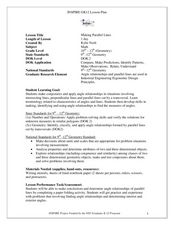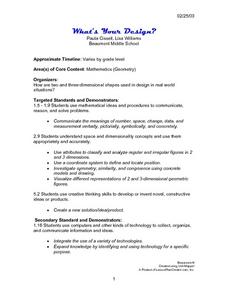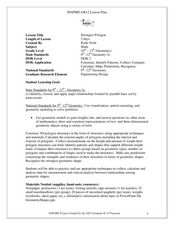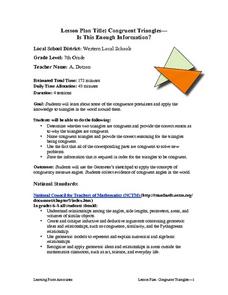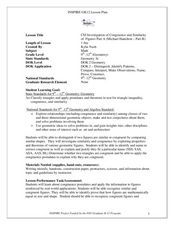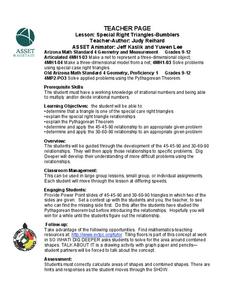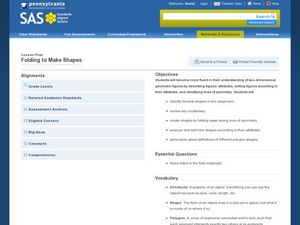Curated OER
Dream Bedroom Floor Plan
Students build and apply concepts of geometry. In this geometry lesson, students create a building using proportions and scale drawings. They use Cabri technology to create a virtual drawing first.
Curated OER
The Minimal Distance Point from the Vertices of a Triangle
Young scholars calculate the distance from the vertex of a triangle to the center. In this geometry lesson, students find the shortest distance between a point and the vertex of a triangle. They relate this concept of distance to the...
Curated OER
Dream Bedroom Floor Plan
Students construct using Cabri software. In this geometry lesson, students convert between units and apply the correct measurements to build objects. They create the room virtually and manipulate the shapes to the desired measurements.
Virginia Department of Education
Similar Triangles
Pupils work in pairs to investigate what it takes to prove that two triangles are similar. They work through various shortcuts to find which are enough to show a similarity relationship between the triangles. Small groups work with the...
Curated OER
Making Parallel Lines
Students differentiate between parallel and perpendicular lines. In this geometry lesson, students make conjectures and apply it to solve real life situations. They collect data and make predictions based on the data.
Curated OER
Incredible Edible Bridges
Pupils create a bridge using engineering and geometric concepts. In this geometry lesson, students identify the missing measures of polygons sides and angles. They work together to solve real life situation using problem solving skills.
Curated OER
What's Your Design?
Sixth grade students: design a stained glass window, submitting their initial plan detailing the measurements of all lines and angles. Seventh grade students: create a scale drawing of their own geometric family of four members.
Curated OER
Strongest Polygon
Students define and identify shapes by name. In this geometry lesson, students construct, identify and compare polygons based on the number of sides. They classify each shape based on their angle sum theorem.
Curated OER
Parallel-o-Home
Students investigate the usage of parallel and perpendicular shapes in the real world. In this geometry lesson, students investigate shapes for properties that are related to the real world. They relate all the properties of shape tot he...
Curated OER
Congruent Triangles - Is This Enough Information?
Seventh graders examine congruence postulates and apply knowledge to triangles in the world around them.
Curated OER
Measuring the Earth
Students identify types of arcs and angles in a circle, find the measure of arcs and angles, and solve real world problems involving lengths of segments in circles, lengths, and areas.
Curated OER
Studying Special Segments in Triangles
Students investigate special segments in triangles. For this geometry lesson, students graph, compare, estimate and predict findings based on their data. They differentiate between similarity and congruence of triangles.
Curated OER
CSI Investigation of Congruence and Similarity
Students differentiate between similarity and congruence using polygons. In this geometry lesson, students label triangles based on their properties. They find missing sides and angles using the interior sum theorem.
Curated OER
Incenter of a Triangle
Tenth graders explore the properties of the incenter of a triangle. In this geometry lesson, 10th graders construct a triangle and the angle bisectors of each angle. The dynamic properties of Cabri Jr. allow students to locate and...
Curated OER
How are Trig Ratios Used to Measure Triangle Sides
Students identify the ratios of trig identities. In this geometry lesson, students solve the missing sides and angles of triangles using trig ratios. They relate the graphs and waves to real life scenarios.
Curated OER
Special Right Triangles
Students identify the different parts of a right triangle. In this geometry lesson, students use the Pythagorean Theorem to identify missing sides and angles of a right triangle. They work with irrational and rational roots.
Curated OER
Compass Designs
Young scholars investigate the properties of two and three dimensional objects. In this geometry lesson, students differentiate polygons based on similarity and congruence. They make observation and interpret the data.
Curated OER
Problem Solving Using Power Polygons
Students investigate geometric shapes by creating figures on a plane. In this polygon lesson plan, students complete a worksheet based on the angles in a power polygon. Students identify the different types of polygons and define their...
Curated OER
Proportional Similarities
Young scholars model the geometric relationship with graphing. In this geometry lesson, students differentiate between parallel, perpendicular, similar and congruent shapes. They use properties of polygons to differentiate their shapes...
Curated OER
Are you in Golden Shape
Students solve and verify the solution for unknown measures. In this geometry lesson, students identify the properties of circles. They use the arc, angle and segment relationship to find the missing measures.
Curated OER
Mathematics in Robotics
Students build and create using math. For this geometry lesson, students differentiate between congruent and similarity as they observe polygons. They create robots with different functions using properties of geometry.
Curated OER
Folding to Make Shapes
Second graders identify different polygons and their attributes. In this geometry instructional activity, 2nd graders get to know polygons by studying the vocabulary and finding polygons in their classroom. They create these shapes and...
Curated OER
The Search for Pythagoras' Treasure
Students identify and define properties of triangles. For this geometry lesson, students identify the missing sides and angles of right triangles. They use the rules of the Pythagorean Theorem to solve their problems.
Curated OER
Make a Box
Students use specific dimensions to create a box. In this geometry lesson plan, students analyze the different properties of two and three dimensional shapes. They make conjectures and use it to solve problems.


